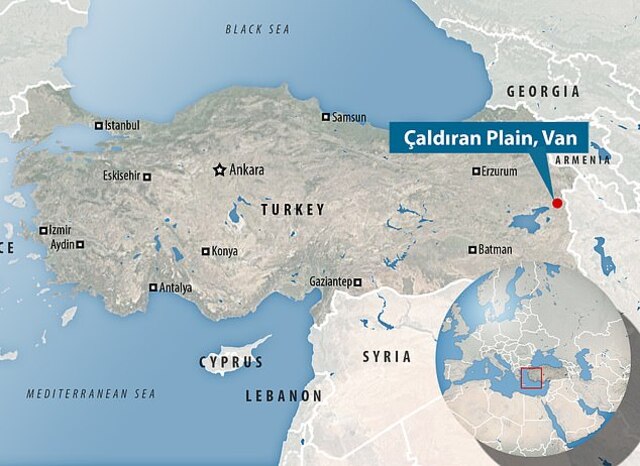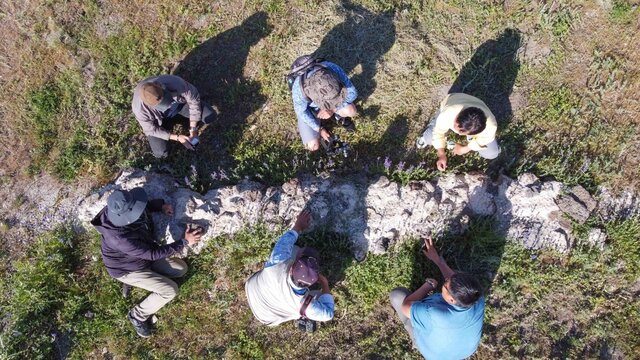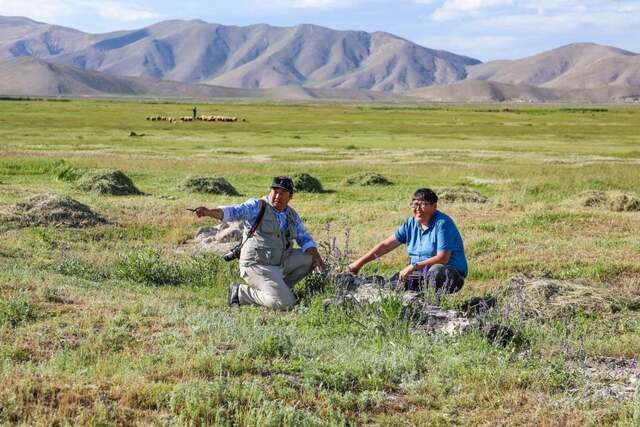In the rugged landscapes of eastern Turkey, a groundbreaking archaeological discovery is shedding new light on one of history’s most notorious Mongol leaders. Researchers have uncovered the ruins of a grand palace that may have belonged to Hulagu Khan, the grandson of the infamous Genghis Khan. The site, located in Van Province, presents an intriguing opportunity to explore the fascinating world of the Ilkhanate, the Mongol dynasty Hulagu established after the division of the Mongol Empire. This discovery, while still under investigation, could provide vital insights into the Mongol Empire’s legacy, and its impact on the Middle East and beyond.
Hulagu Khan: The Legacy of a Bloodthirsty Warlord
Hulagu Khan, born around 1217, was a Mongol military leader whose campaigns are still remembered for their ruthlessness and far-reaching consequences. As the grandson of Genghis Khan, Hulagu inherited the immense Mongol Empire, which, under his leadership, continued its expansion into the Middle East. His most infamous conquest occurred in 1258 when he led the Mongol army in the sack of Baghdad, which marked one of the most brutal episodes in Islamic history.

The sack of Baghdad resulted in the massacre of countless civilians and the destruction of the House of Wisdom, a library that housed centuries of knowledge. It is estimated that Hulagu’s forces killed hundreds of thousands, including the Caliph of Baghdad, Al-Musta’sim Billah, ending the reign of the Abbasid Caliphate. While Hulagu’s legacy is often associated with violence, his establishment of the Ilkhanate played a significant role in shaping the history of the region.
Video
Watch this video to discover why Genghis Khan’s tomb will likely never be found, exploring the mystery and historical factors behind it.
The Mongol Empire’s Fragmentation and Hulagu’s Ilkhanid State
After the death of Genghis Khan, the Mongol Empire, once unified under his rule, began to fragment. The territories were divided among his sons, and Hulagu Khan took control of the Ilkhanate, which covered much of modern-day Iran, Iraq, Turkey, and parts of Central Asia. This division marked the rise of Hulagu’s power in the Middle East, where he continued his military campaigns and sought to expand Mongol influence further west.

The Ilkhanate was a formidable state, and Hulagu’s rule continued the Mongol tradition of cultural exchange and military dominance. Despite the violent conquests that marked his early career, Hulagu also worked to integrate the region by supporting trade, infrastructure, and the spread of knowledge. His reign, though short-lived, was instrumental in the Mongol Empire’s lasting influence on the Islamic world and the broader Eurasian continent.
The Mysterious Summer Palace: Historical Records and Clues
Historical records describe Hulagu Khan’s summer palace in the region around Lake Van in modern-day eastern Turkey, but the exact location had remained a mystery for centuries. The 13th-century Armenian historian, Kirakos of Ganja, wrote of a magnificent palace built by Hulagu Khan in this region. However, no concrete evidence was available until recent excavations began to reveal the site’s significance.

Scholars have long debated the location of this palace, with some suggesting it was near Lake Urmiya, while others pointed to the vicinity of Lake Van. The site discovered by archaeologists in Van Province appears to match the historical descriptions of Hulagu Khan’s summer residence. This location, rich in Mongol heritage, could serve as an essential key to understanding Hulagu’s influence and the cultural and political life of the Ilkhanate.
The Archaeological Excavation: What’s Been Uncovered
The excavation site in Van Province has already yielded impressive finds that suggest the ruins belong to Hulagu Khan’s palace. The archaeologists working on the site, led by Ersel Çağlıtütuncigil, have uncovered glazed ceramics, pottery, porcelain, bricks, and roof tiles. These artifacts, although looted in the past, provide essential clues about the architectural style and grandeur of the palace.
Notably, the team discovered roof tiles featuring ‘svastika’ or ‘tamga’ symbols, which were considered power symbols of the Mongol Khans. These distinctive symbols are integral in connecting the site to Hulagu Khan. According to Munkhtulga Rinchinkhorol of the Mongolian Academy of Sciences, these symbols are a powerful indicator that the palace was indeed built by or for Hulagu Khan. This discovery lends credibility to the theory that the ruins uncovered in Van Province represent the lost summer palace of Hulagu Khan.
Tamga Symbols: Connecting the Past with the Mongol Empire
The discovery of tamga symbols—distinctive markings often used by Mongol Khans to signify authority—adds weight to the claim that the ruins belong to Hulagu Khan. These symbols, which can be traced back to pre-Mongol cultures and were later incorporated into Mongol iconography, played a significant role in the Mongols’ use of symbols to assert their power and dominance.
The appearance of these symbols on roof tiles and other artifacts found at the excavation site reinforces the connection between the location and the Ilkhanate. The tamga symbols, once used as a way of branding property and identifying ownership, were vital to Mongol rulers, and their presence at the site helps confirm the palace’s association with Hulagu Khan’s reign.
Looted but Not Forgotten: Insights from the Ruins
Although the site has been heavily looted over time, significant portions of the palace remain intact, offering valuable insights into its structure and function. The discovery of a caravanserai—an inn used by travelers on the Silk Road—further connects the site to the Mongol Empire’s extensive trade networks. These caravanserais were vital to the maintenance of the Silk Road and provided safe havens for merchants, travelers, and soldiers.
The presence of a caravanserai in the ruins suggests that Hulagu Khan’s palace was not only a symbol of his power but also a hub for trade and cultural exchange. As the Mongols controlled vast territories and played a key role in facilitating commerce between the East and the West, the palace likely served as an important center for administration and diplomacy in the Ilkhanate.
Challenges in Identifying Hulagu Khan’s Palace
While the evidence points to the ruins being the long-lost palace of Hulagu Khan, experts are cautious about making a definitive claim without further investigation. Timothy May, a professor of Central Eurasian History at the University of North Georgia, notes that more research is needed to confirm the identity of the palace. Other scholars have also expressed similar views, acknowledging that while the evidence is compelling, it remains inconclusive.
Despite these uncertainties, the discovery of the site is significant in its own right, providing valuable clues about the architectural and cultural heritage of the Mongol Empire. Further excavations and studies will be crucial in verifying the site’s connection to Hulagu Khan and uncovering more about the life and legacy of the Mongol ruler.

The Road Ahead: Further Excavations and Discoveries
The excavation team, which includes both Turkish and Mongolian scholars, is committed to continuing their work at the site. With further investigation, researchers hope to uncover more details about the palace, including the rumored church built by Hulagu Khan for his wife. Additionally, scholars aim to explore the broader historical context of the Ilkhanate and its role in the Mongol Empire’s history.
As the excavation progresses, there is hope that more significant findings will be made, shedding light on the opulence and complexity of Hulagu Khan’s reign. This discovery, while still in its early stages, has the potential to reshape our understanding of the Mongol Empire’s influence in the Middle East and offer a deeper insight into the culture and power structures of the Ilkhanate.
Video
Check out this video, Chinggis Khaanii Magtaal by Batzorig Vaanchig, to experience a powerful tribute to the legacy of Genghis Khan through music.
Conclusion: The Legacy of Hulagu Khan
The discovery of what may be Hulagu Khan’s summer palace in Van Province, Turkey, is a remarkable breakthrough in the field of archaeology. While questions remain about the site’s definitive identification, the evidence gathered so far points strongly to its association with the Mongol warlord. The tamga symbols, architectural artifacts, and the presence of a caravanserai all provide compelling evidence of the palace’s significance in the history of the Ilkhanate.
This excavation represents a crucial step in uncovering the forgotten remnants of Hulagu Khan’s legacy. As researchers continue to investigate the site, we may soon learn more about the structure’s true identity, providing valuable insights into one of the most powerful dynasties in history and its enduring impact on the world.



